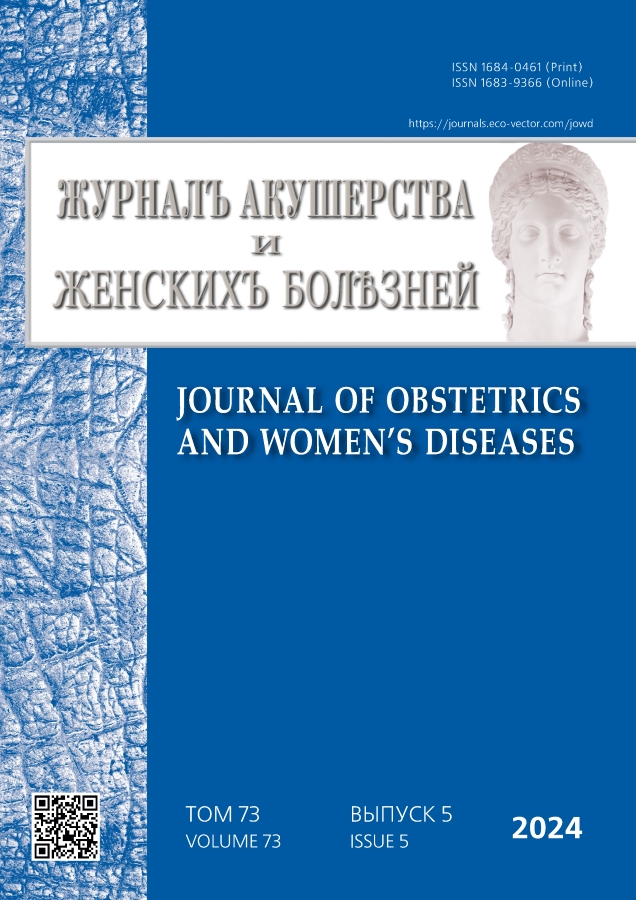Organ-preserving laparoscopic myomectomy in atypical leiomyoma arrangement
- Authors: Ivanova D.A.1, Filippov O.S.2,3, Soloveva E.A.1, Chugunova N.A.1, Uryupina A.P.1, Utkina A.M.1
-
Affiliations:
- Novorossiysk Clinical Center of the Federal Medical and Biological Agency
- Federal Scientific and Clinical Center for Children and Adolescents of the Federal Medical and Biological Agency
- State Research Center – A.I. Burnazyan Federal Medical Biophysical Center of Federal Medical Biological Agency
- Issue: Vol 73, No 5 (2024)
- Pages: 24-29
- Section: Original study articles
- URL: https://bakhtiniada.ru/jowd/article/view/279768
- DOI: https://doi.org/10.17816/JOWD634241
- ID: 279768
Cite item
Abstract
BACKGROUND: Uterine fibroids are the most common cause of surgical treatment in women and total hysterectomy is performed in most cases to radically solve this problem. The organ-preserving approach aims to preserve fertility and the ability to reproduce in patients of reproductive age. The atypical location of leiomyomas complicates the possibility of performing an organ-preserving myomectomy.
AIM: The aim of this study was to assess the possibility of performing myomectomy for atypical leiomyoma using laparoscopic access in routine practice to preserve fertility and implement reproductive plans.
MATERIALS AND METHODS: This study included 213 patients of reproductive age with uterine fibroids. Myomectomy for typical or atypical leiomyomas was performed by laparoscopic access. A comparative analysis of surgical treatment and perioperative management of patients with atypically located fibroids and fibroids of other localization was carried out. The results of the achievement by the patients of their reproductive goals were evaluated. The duration of follow-up was 24 months.
RESULTS: Atypical node location was noted in 65 (30.5%) cases. When comparing the duration of surgical treatment, volume of blood loss, need for analgesics, presence of intraoperative and postoperative complications, duration of hospitalization and recovery period in patients with atypical leiomyoma, these parameters did not differ from those in the surgical treatment of patients with typical leiomyoma. Anatomical and functional results of surgical treatment were analyzed after one, three, six, 12, and 24 months. Of the 70 patients planning pregnancy, 26 (37%) women became pregnant on average 8.3 months after surgery. The location of the removed fibroids was atypical in ten cases.
CONCLUSIONS: The atypical location of leiomyoma does not affect the course of the surgical and postoperative periods and long-term results of surgical treatment. The possibility of routine organ-preserving treatment by laparoscopic access in patients with atypical fibroids leaves prospects for the implementation of the woman’s reproductive plans.
Keywords
Full Text
##article.viewOnOriginalSite##About the authors
Darya A. Ivanova
Novorossiysk Clinical Center of the Federal Medical and Biological Agency
Email: daria.andreevna1995@mail.ru
ORCID iD: 0009-0006-1942-7516
MD
Russian Federation, 26 Sacco and Vanzetti St., Novorossiysk, Krasnodar Region, 353901Oleg S. Filippov
Federal Scientific and Clinical Center for Children and Adolescents of the Federal Medical and Biological Agency; State Research Center – A.I. Burnazyan Federal Medical Biophysical Center of Federal Medical Biological Agency
Email: filippovolsem@yandex.ru
ORCID iD: 0000-0003-2654-1334
SPIN-code: 4404-4584
MD, Dr. Sci. (Medicine), Professor, Honored Doctor of the Russian Federation, University of Innovation and Continuing Education
Russian Federation, Moscow; MoscowElena A. Soloveva
Novorossiysk Clinical Center of the Federal Medical and Biological Agency
Author for correspondence.
Email: solovevaln@inbox.ru
ORCID iD: 0009-0004-9442-8645
SPIN-code: 3678-7099
MD, Cand. Sci. (Medicine)
Russian Federation, 26 Sacco and Vanzetti St., Novorossiysk, Krasnodar Region, 353901Nina A. Chugunova
Novorossiysk Clinical Center of the Federal Medical and Biological Agency
Email: nkc@nkc-fmba.ru
ORCID iD: 0009-0003-3345-579X
MD
Russian Federation, 26 Sacco and Vanzetti St., Novorossiysk, Krasnodar Region, 353901Anna P. Uryupina
Novorossiysk Clinical Center of the Federal Medical and Biological Agency
Email: anna.petra3@mail.ru
ORCID iD: 0009-0008-3348-3631
MD
Russian Federation, 26 Sacco and Vanzetti St., Novorossiysk, Krasnodar Region, 353901Anna M. Utkina
Novorossiysk Clinical Center of the Federal Medical and Biological Agency
Email: annautkina83@gmail.com
ORCID iD: 0009-0000-1757-0307
MD
Russian Federation, 26 Sacco and Vanzetti St., Novorossiysk, Krasnodar Region, 353901References
- Arutyunova EE, Katkova AS, Buralkina NA. Ethnogeography of uterine fibroids: epidemiology, age and race differences, types of surgery. Consilium Medicum. 2018;20(6):26–30. EDN: UZEXJI doi: 10.26442/2075-1753_2018.6.26-30
- Stewart EA, Cookson CL, Gandolfo RA, et al. Epidemiology of uterine fibroids: a systematic review. BJOG. 2017;124(10):1501–1512. doi: 10.1111/1471-0528.14640
- Seregin AA, Nadezhdenskaia AB, Makarova AS, et al. Uterine fibroids, laparoscopic surgery and morcellation: comparative analysis of the results of organ-preserving operations. Gynecology. 2021;23(1):73–77. EDN: JQBEKV doi: 10.26442/20795696.2021.1.200561
- Tskhay VB, Schtoh EA. Uterine fibroids and women’s reproductive funcction. Communication uterine fibroids with infertility. Obstetrics, Gynecology and Reproduction. 2014;6(4):42–47. EDN: TMKODL
- Averiaskina MN, Bakhtiyarov KR. The effect of various surgical techniques in myomectomy on reproductive outcomes (a review). Russian Journal of Human Reproduction. 2024;30(1):109–115. EDN: OSLGPF doi: 10.17116/repro202430011109
- Saveleva GM, Sukhikh GT, Serov VN, et al, editors. Gynecology. National guide. Short edition. Moscow: GEOTAR-Media; 2020. 1044 p. (In Russ.)
- Carranco RC, Vigeras A, Ribeiro R, et al. Laparoscopic variants of temporary uterine artery ligation. J Minim Invasive Gynecol. 2020;27(4):811–812. doi: 10.1016/j.jmig.2019.08.026
- Donnez J, Dolmans MM. Uterine fibroid management: from the present to the future. Hum Reprod Update. 2016;22(6):665–686. doi: 10.1093/humupd/dmw023
- Metwally M, Raybould G, Cheong YC, et al. Surgical treatment of fibroids for subfertility. Cochrane Database Syst Rev. 2020;1(1). doi: 10.1002/14651858.CD003857.pub4
- Ordás P, Spagnolo E, Fernández LG, et al. Comparison of surgical and obstetric outcomes in women with uterine leiomyomas after laparoscopic vs. abdominal myomectomy: a single-center cohort study. Front Surg. 2022;9. doi: 10.3389/fsurg.2022.997078
- Mokhov EM, Kadykov VA, Sergeev AN, et al. Pain scoring systems and their application features in medicine (literature review). Upper Volga Medical Journal. 2019;18 (2):34–37. EDN: DEYKPY
- Hawker GA, Mian S, Kendzerska T, French M. Measures of adult pain: Visual Analog Scale for Pain (VAS Pain), Numeric Rating Scale for Pain (NRS Pain), McGill Pain Questionnaire (MPQ), Short-Form McGill Pain Questionnaire (SF-MPQ), Chronic Pain Grade Scale (CPGS), Short Form-36 Bodily Pain Scale (SF-36 BPS), and Measure of Intermittent and Constant Osteoarthritis Pain (ICOAP). Arthritis Care Res (Hoboken). 2011;63(Suppl 11):S240–S252. doi: 10.1002/acr.20543
Supplementary files






